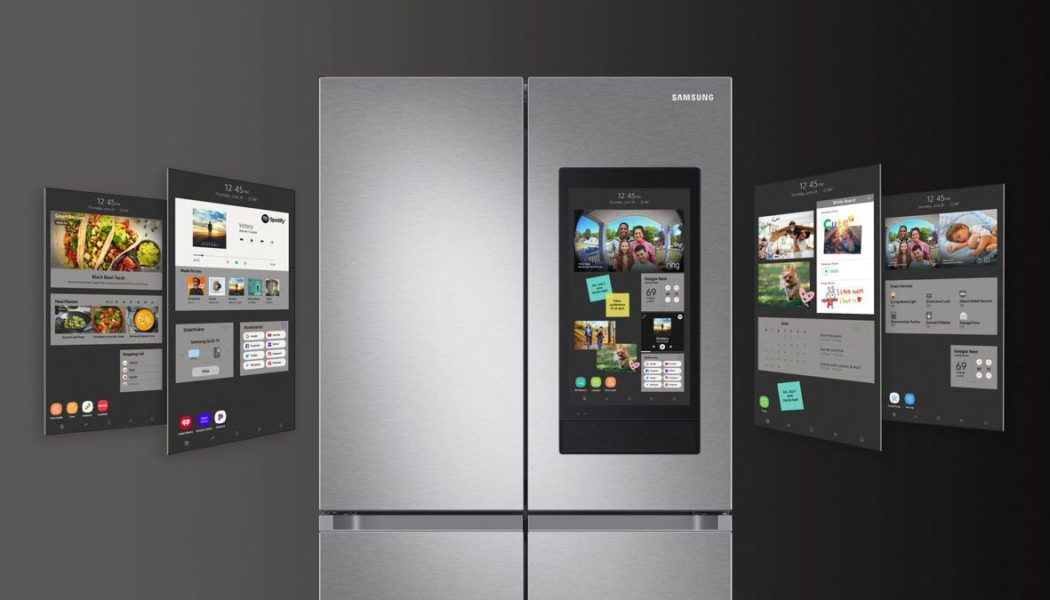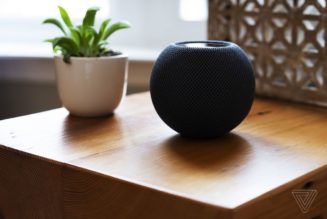Samsung introduced its first standalone SmartThings smart home controller at CES 2022. The Samsung Home Hub is designed to be a central place for a household to control and monitor their smart home without having to buy a $4,000 smart fridge.
While there are precious few details about this new device, other than it’s not coming to the US yet and will launch in Korea in the first half of 2022, from the one picture we’ve got, it looks good. Honestly, it looks like the smart home controller we wish Apple, Amazon, or Google would make.
The transition from smartphone control of the smart home to voice control has not been a seamless one. There are many times when it’s easier to tap on a screen to turn on the lights or lock the back door than it is to raise your voice, and a simple, easily accessible interface to do this is something the smart home still needs.
Smart displays from Google and Amazon have largely failed to provide a usable dashboard for this type of control, instead requiring multiple swipes and taps to get to what you need. These displays also try to be multitaskers in the home, part calendar, part radio, part TV, part smart home device, partly failing to do well most of what they attempt.
Case in point, Amazon’s new Echo Show 15, which I thought would be the solution I’d been looking for to control my smart home, since I took down the aging iPad Mini I had installed in my wall. (Its screen finally gave up the ghost — turns out being permanently plugged in and sitting vertically on my wall for four years was not good for it.)
Sadly, the software on the Show 15 doesn’t live up to the promise of the hardware and while it looks fantastic, its limited smart home controller interface means it just won’t work for my home.
What I, and many like me, want is a dedicated smart home dashboard, something that has shortcuts to control devices, trigger scenes, and view live camera feeds. That’s not to say there isn’t room for Echo Shows and Google Nest Hubs that do part of what they’re supposed to do really well. But a dedicated smart home interface mounted on a wall or set up on a counter is what is needed.
There are a few attempts at solving this problem out there — the touchscreen Brilliant Control Panel that replaces your existing light switches is an innovative solution that takes advantage of a house’s existing wiring. But installing that system in every room will set you back a pretty penny and the screen is much smaller than a tablet, making it less intuitive for all users.
:no_upscale()/cdn.vox-cdn.com/uploads/chorus_asset/file/23145171/2021_0611_Samsung_4D_Flex_Family_Hub_Menus_scaled.jpg)
What I like about Samsung’s Home Hub so far is its size, its orientation, and its potential portability. A vertical screen is actually more useful for smart home control than a horizontal one, as you can fit more icons on the screen that way and ideally have quick access to more controls. The stand for the Samsung Home Hub looks like it could also hold the screen horizontally if you preferred that, and it all looks easy enough to pick up and move into a different room when required.
I’ve used the Samsung Family Hub smart fridge, and the Home Hub interface looks similar. It also largely resembles a blown-up version of Samsung’s SmartThings smartphone app. There’s a Favorites home screen with your favorite devices on it and shortcuts to screens to access services such as SmartThings Cooking, a Devices page, a Life page where you’ll find Samsung’s connected services — such as Cooking, Clothing Care, Energy, Pet, and Air, and an Automations page, plus and intriguing More tab.
It’s not the smart home dashboard of my dreams, but it is a step in the right direction: a dedicated device for controlling the many aspects of your smart home that doesn’t attempt to do unnecessary party tricks but gives you and your household an easy way to turn the home on and off.
Speaking of Samsung’s connected services, the SmartThings Energy Service, which monitors the power usage of all compatible connected devices and recommends ways for you to save energy based on usage patterns, is being expanded to include more products and services. Samsung also announced partnerships earlier this year that enable real-time monitoring of whole-home energy consumption in the SmartThings App. This type of integration should allow homeowners to set up automations based on energy costs or demand response events.
During its CES keynote, Samsung also announced that it’s a founding member of the newly minted Home Connectivity Alliance (HCA). Founded in September 2021, the HCA’s main goal is creating “Cloud to cloud interoperability across brands,” according to its website. Samsung’s press release stated the Alliance will help “ensure that having devices across multiple brands doesn’t require you to compromise your smart home experience.”
Samsung is also part of Matter, a new smart home standard with similar goals. How this initiative will fit in with Matter is unclear at this stage. Matter is a local protocol, with devices communicating primarily over a local network while still allowing IP access to connect to the internet. This new Alliance appears to be focused on expanding connectivity between cloud-based services. This is something Samsung has been pursing more aggressively since it started to transition its SmartThings platform from a hardware-based smart home hub to a software-based service.









